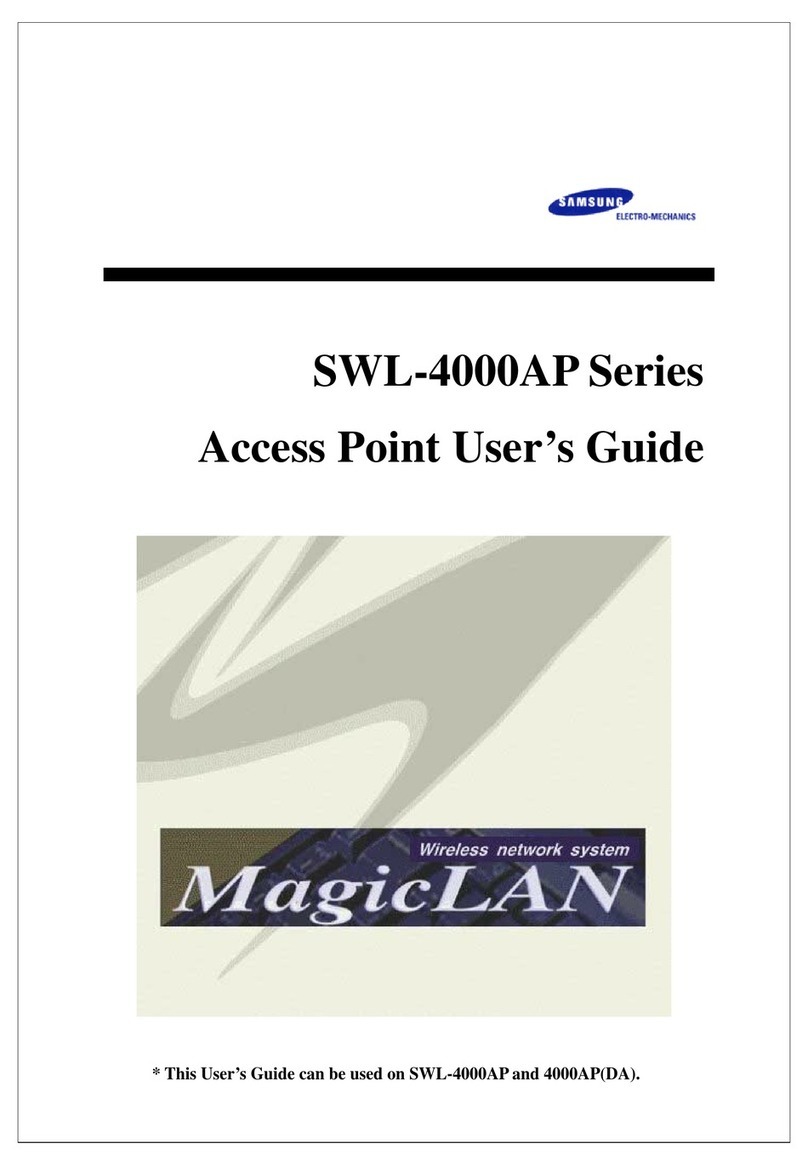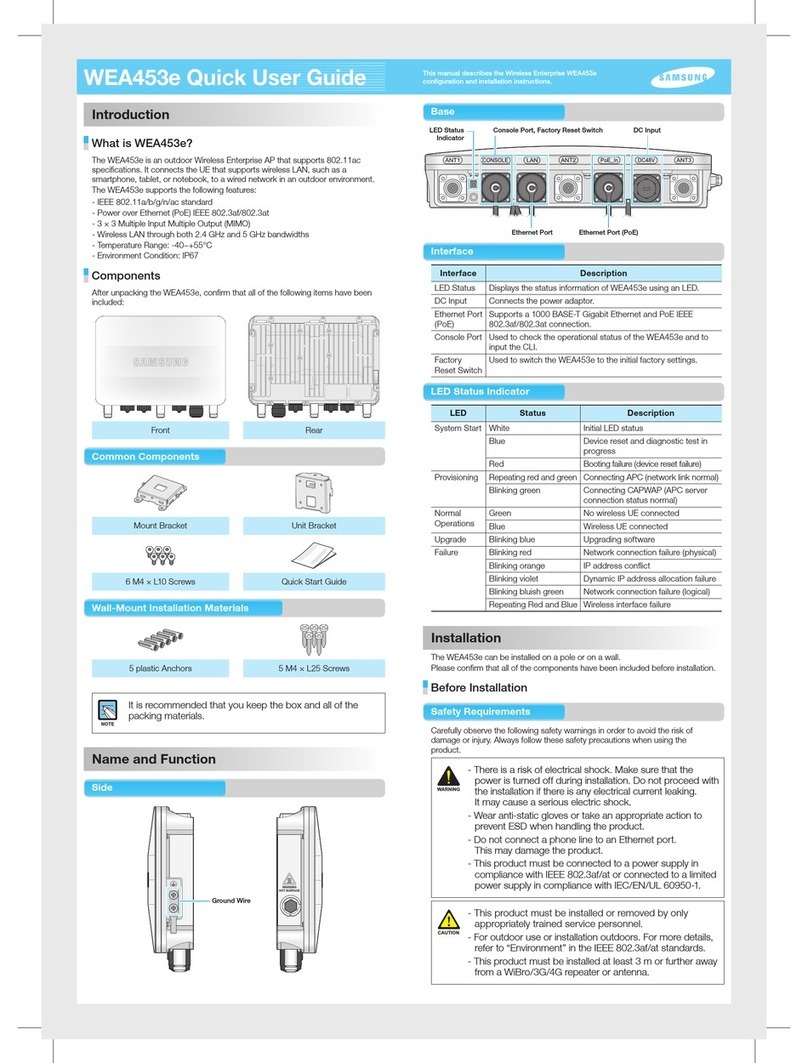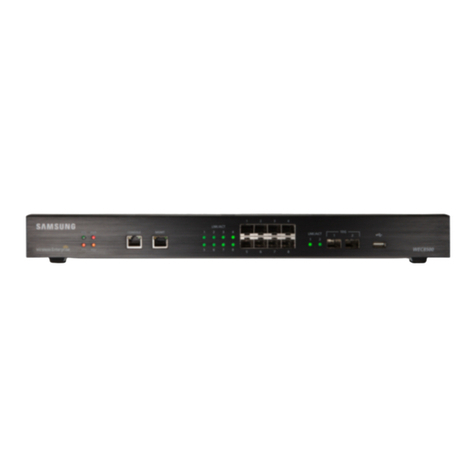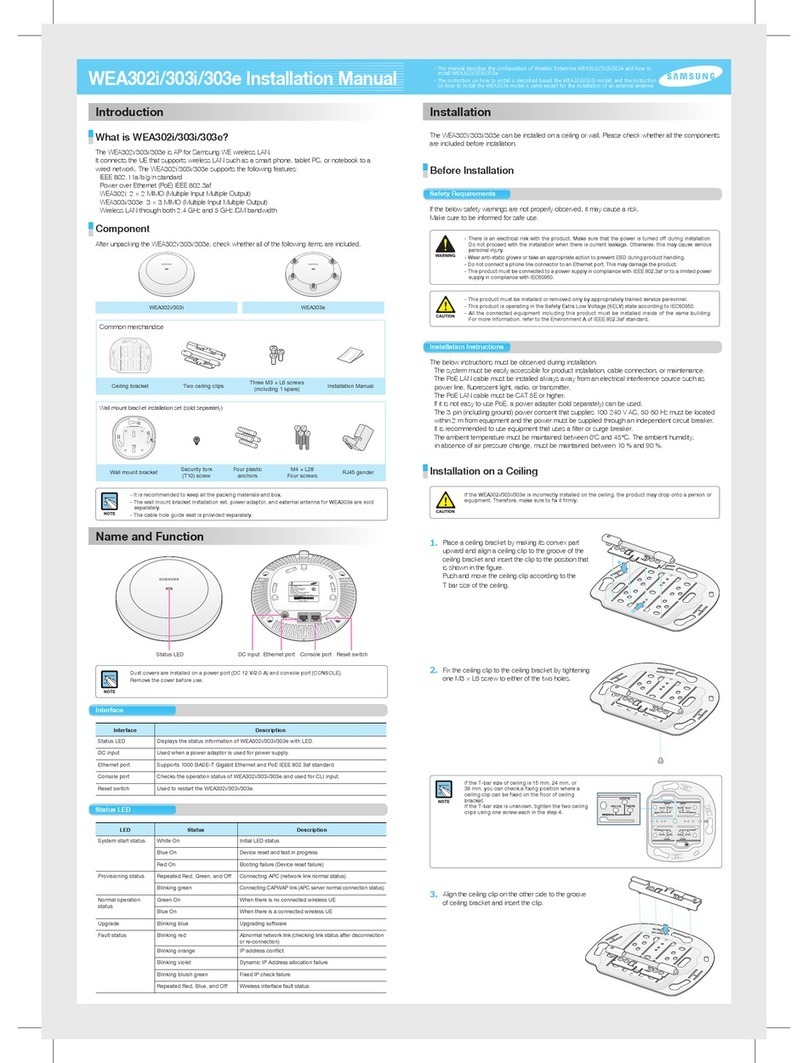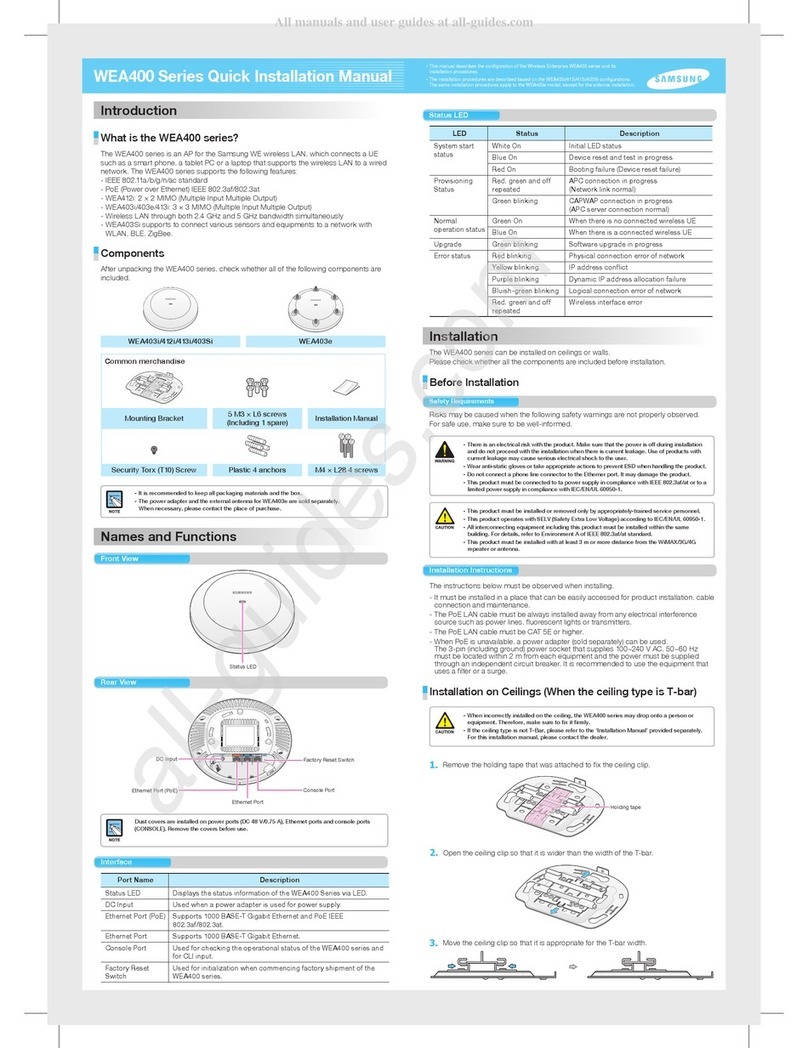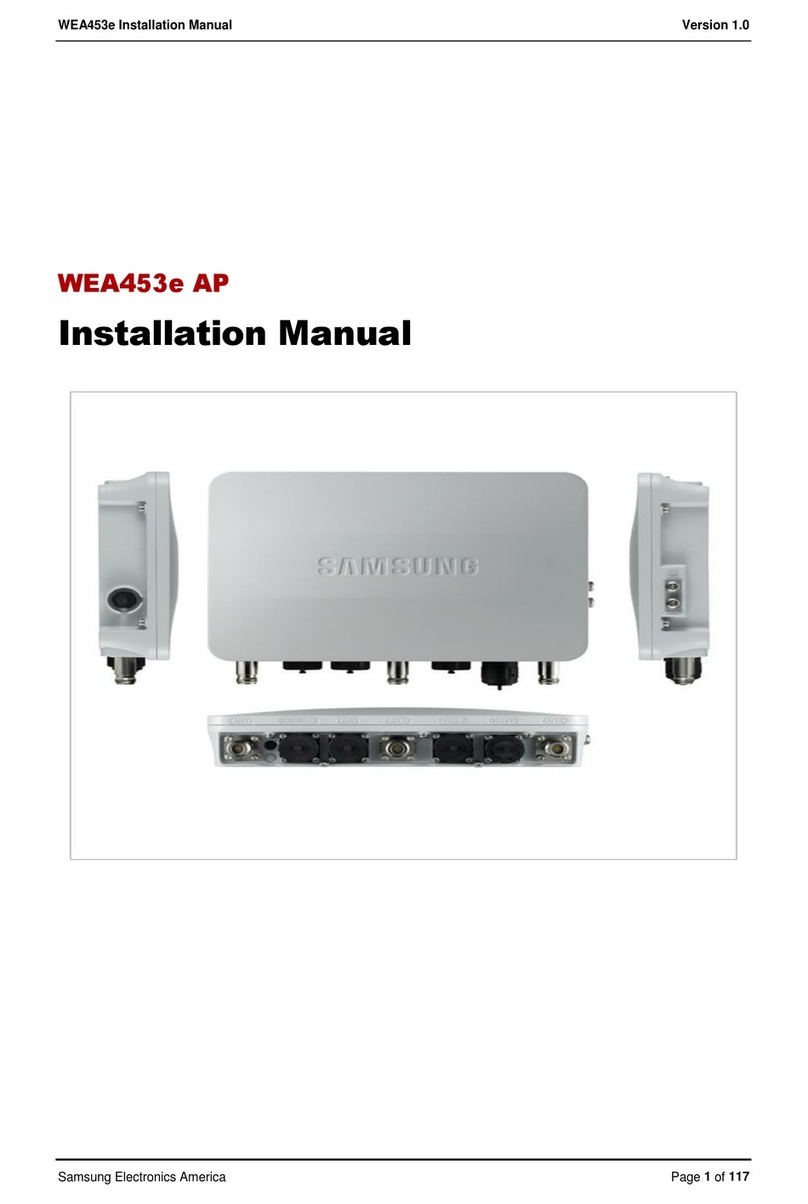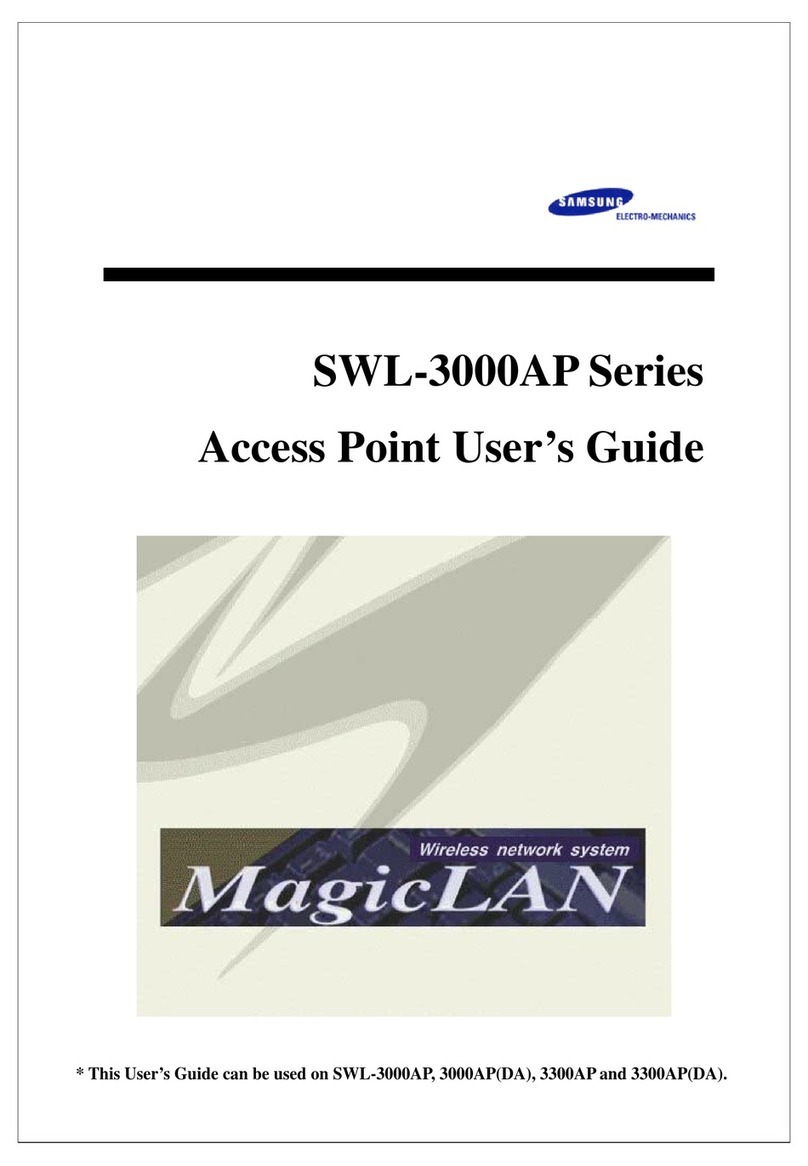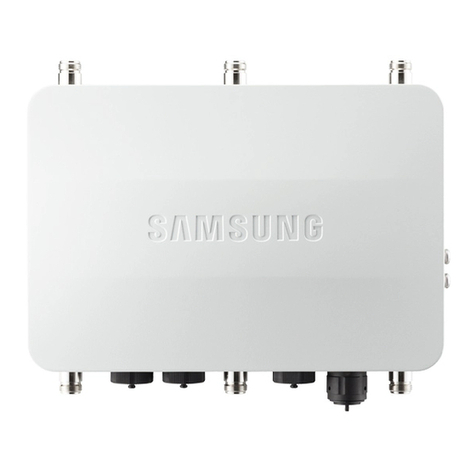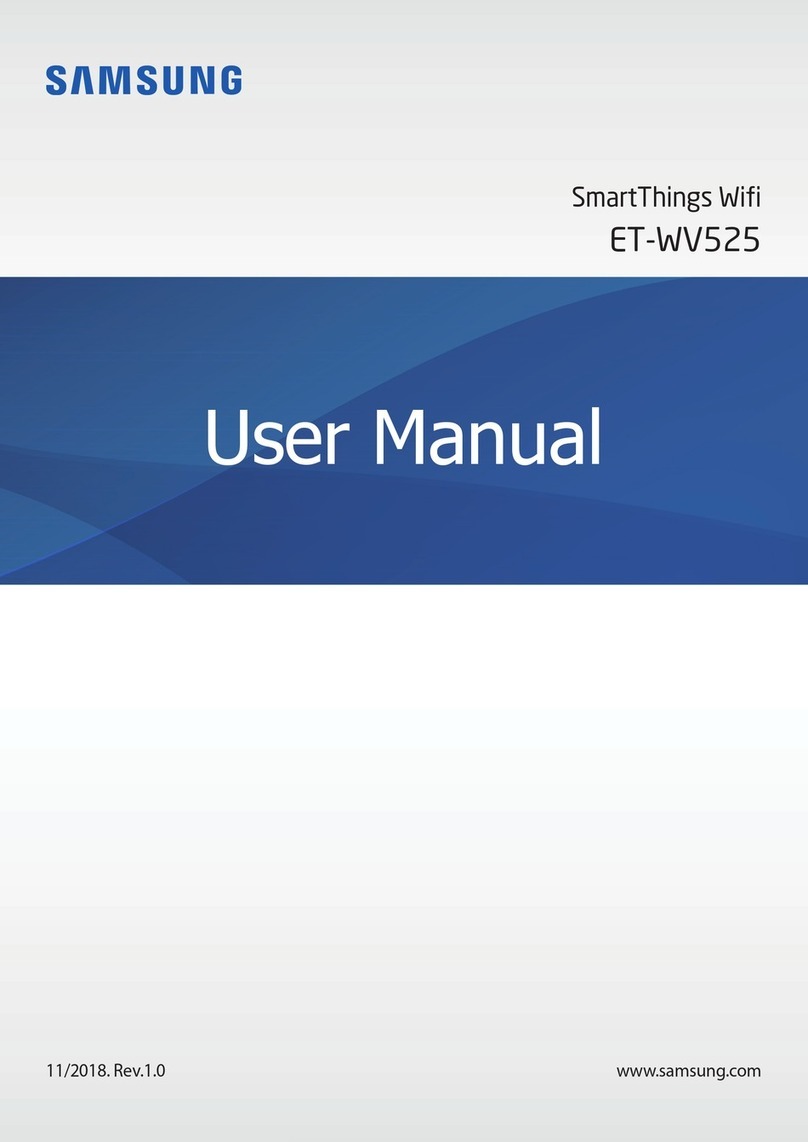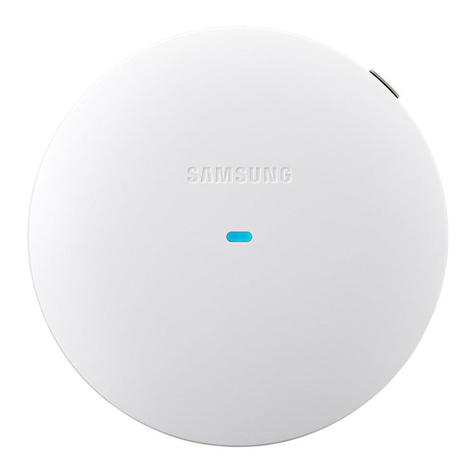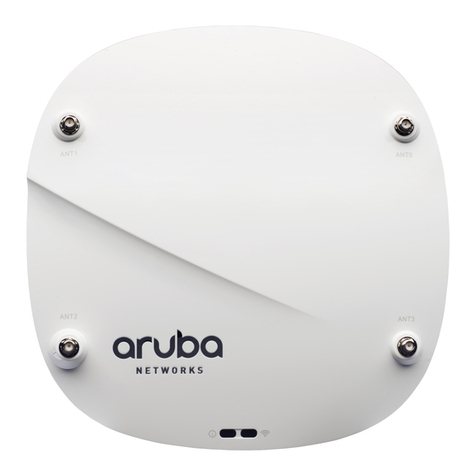
5. Insert a LAN cable into the Ethernet port (PoE) on
the back side of the WEA400/500 series.
If PoE is not supported, connect the power
adapter to the DC input on the back of the
WEA400/500 series.
The wall
For the WEA403e model, remove the protection cap from the antenna connector and install the
external antenna (separately purchased). The 3 types of antennas that can be installed to the
WEA403e model are listed below. (More antenna types may be added in the future.)
Low gain dipole antenna Patch antennaHigh gain dipole antenna
Installing Anti-Theft Lock Cable
When installing the WEA400/500 series AP in a public place, it is recommended to use anti-
theft lock cables to prevent any loss. (An anti-theft lock cable can be purchased separately and
a variety of products can be found in the market.)
1. Connect the anti-theft lock cable to the WEA400/500 series AP.
or
2. Turn the lock cable key to lock the cable.
3. Remove the key from the lock cable and keep it in a separate location.
Using the anti-theft Torx screws
The WEA400/500 series AP products can be prevented from being stolen when tightening the
Torx screws as shown below. (Torx screws can be easily tightening when they are fixed to the
mount bracket before assembling the AP product.)
This equipment has been tested and found to comply with the limits for a Class B digital device, pursuant to part 15 of the FCC Rules.
These limits are designed to provide reasonable protection against harmful interference in a residential installation. This equipment generates,
uses and can radiate radio frequency energy and, if not installed and used in accordance with the instructions, may cause harmful interference
to radio communications. However, there is no guarantee that interference will not occur in a particular installation. If this equipment does
cause harmful interference to radio or television reception, which can be determined by turning the equipment off and on, the user is
encouraged to try to correct the interference by one or more of the following measures:
- Reorient or relocate the receiving antenna.
- Increase the separation between the equipment and receiver.
- Connect the equipment into an outlet on a circuit different from that to which the receiver is connected.
- Consult the dealer or an experienced radio/TV technician for help.
Changes or modifications not expressly approved by the party responsible for compliance
could void the user’s authority to operate the equipment.
The 5150-5250 MHz band is restricted to indoor use only.
This device complies with Industry Canada licence-exempt RSS standard(s). Operation is subject to the following two conditions: (1) this
device may not cause interference, and (2) this devicemust accept any interference, including interference that may cause undesired
operation of thedevice.
Le présent appareil est conforme aux CNR d’Industrie Canada applicables aux appareils radio exempts de licence.
L’exploitation est autorisée aux deux conditions suivantes: (1) l’appareil ne doit pas produire de brouillage, et (2) l’utilisateur de l'appareil doit
accepter tout brouillage radioélectrique subi, même si le brouillage est susceptible d’en compromettre le fonctionnement.
FCC RF Radiation Exposure Statement:
This equipment complies with FCC RF radiation exposure limits set forth for an uncontrolled environment.
This equipment should be installed and operated with a minimum distance of 50 cm between the radiator and your body.
This transmitter must not be co-located or operating in conjunction with any other antenna or transmitter.
RSS-102 RF Exposure
L’antenne (ou les antennes) doit être installée de façon à maintenir à tout instant une distance minimum de au moins 50 cm ntre la source de radiation
(l’antenne) et toute personne physique. Cet appareil ne doit pas être installé ou utilisé en conjonction avec une autre antenne ou émetteur.
Should the access point be installed in a ceiling with ventilation, the AP ETHERNET PORT must
be horizontally placed.
Class B Equipment (For Home Use Broadcasting & Communication Equipment)
This equipment is home use (Class B) electromagnetic wave suitability equipment and to be used mainly at home and it can
be used in all areas.
Electromagnetic Wave Suitability Notice
Regulatory Information
‘Hereby, Samsung Electronics, declares that this WEA400/500 is in compliance with the essential requirements and other relevant
provisions of Directive 1999/5/EC.’
The original Declaration of Conformity may be found at http://www.samsungdocs.com, go to Search Product and enter the model name.
AEEE Yönetmeliğine Uygundur (Compliant with WEEE)
产品中有害物质的名称及含量
部件名称
有害物質
铅
(Pb)
汞
(Hg)
镉
(Cd)
六价铬
(Cr
6+
)
多溴联苯
(PBB)
多溴二苯醚
(PBDE)
金屬 料件 ×○○○○○
印刷电路板部件 ×○○○○○
線材 ×○○○○○
塑膠件 ○○○○○○
本表格依据SJ/T11364的规定编制
○: 表示该有害物质在该部件所有均质材料中的含量均在GB/T26572规定的限量要求以下。
×: 表示该有害物质至少在该部件的某一均质材料中的含量超出GB/T26572规定的限量要求。本表格提供的信息是基于供应商提供的数
据及三星公司的检测结果。在当前技术水平下、所有有毒有害物质或元素的使用控 制到了最底线。三星公司会继续努力通过改善技术
来减少这些物质和元素的使用。
http://www.samsungenterprise.com
Part No.: EC00-00000A (Ver.1.0)
4. Fix the ceiling clip in place by
tightening the 4 designated screws.
Screws for fixing
the ceiling clip
5. Fix the T-bar in place by fastening
the screws (total of 2) that are on
the ceiling clip.
Screws for
fixing T-bar
If the T-bar size of the ceiling is 15 mm, 24 mm or
38 mm, the position to fix the ceiling clip can be
checked from the bottom surface of the mount
bracket. If the T-bar size is unknown, push the
ceiling clip to check the fixing positions.
6. Pull out a LAN cable through a hole on
the ceiling and connect is to an Ethernet
port (PoE) on the back side of the
WEA400/500 series.
Exterior of the ceiling
If PoE is not supported, connect the power adapter to the DC input on the back side of the
WEA400/500 series. The output of the power adapter is 48 V/0.75 A and is not compatible with
the 12 V/2 A output power adapter that is used by the previous WEA302i/303i/303e AP.
7. Align the WEA400/500 series with
the 3 holes on the mount bracket
and then turn clockwise to fix it
in place. Clean up the ceiling and
other cables.
Interior of the ceiling
Installation on Walls
1. Remove the holding tape that was
attached to fix the ceiling clip.
Holding tape
2. Remove the ceiling clip from the mount bracket.
3. Place the mount bracket on the wall.
Mark and drill 4 screws in appropriate spots.
4. Use a hammer to insert
4 plastic anchors into the
drilled holes on the wall.
Align the inserted plastic
anchors and the screw
holes of the bracket.
Fix the bracket to the wall
by fastening four M4 × L28
screws.
IC Information to User
“This device complies with Industry Canada licence-exempt RSS standard(s). Operation is subject to the following two
conditions: (1) this device may not cause interference, and (2) this device must accept any interference, including
interference that may cause undesired operation of the device.”
Cet appareil est conforme avec Industrie Canada RSS standard exempts de licence(s), Son utilisation est soumise à Les deux
conditions suivantes: (1) cet appareil ne peut pas provoquer d’interférences et (2) cet appareil doit accepter Toute
interférence, y compris les interférences qui peuvent causer un mauvais fonctionnement du dispositif.
